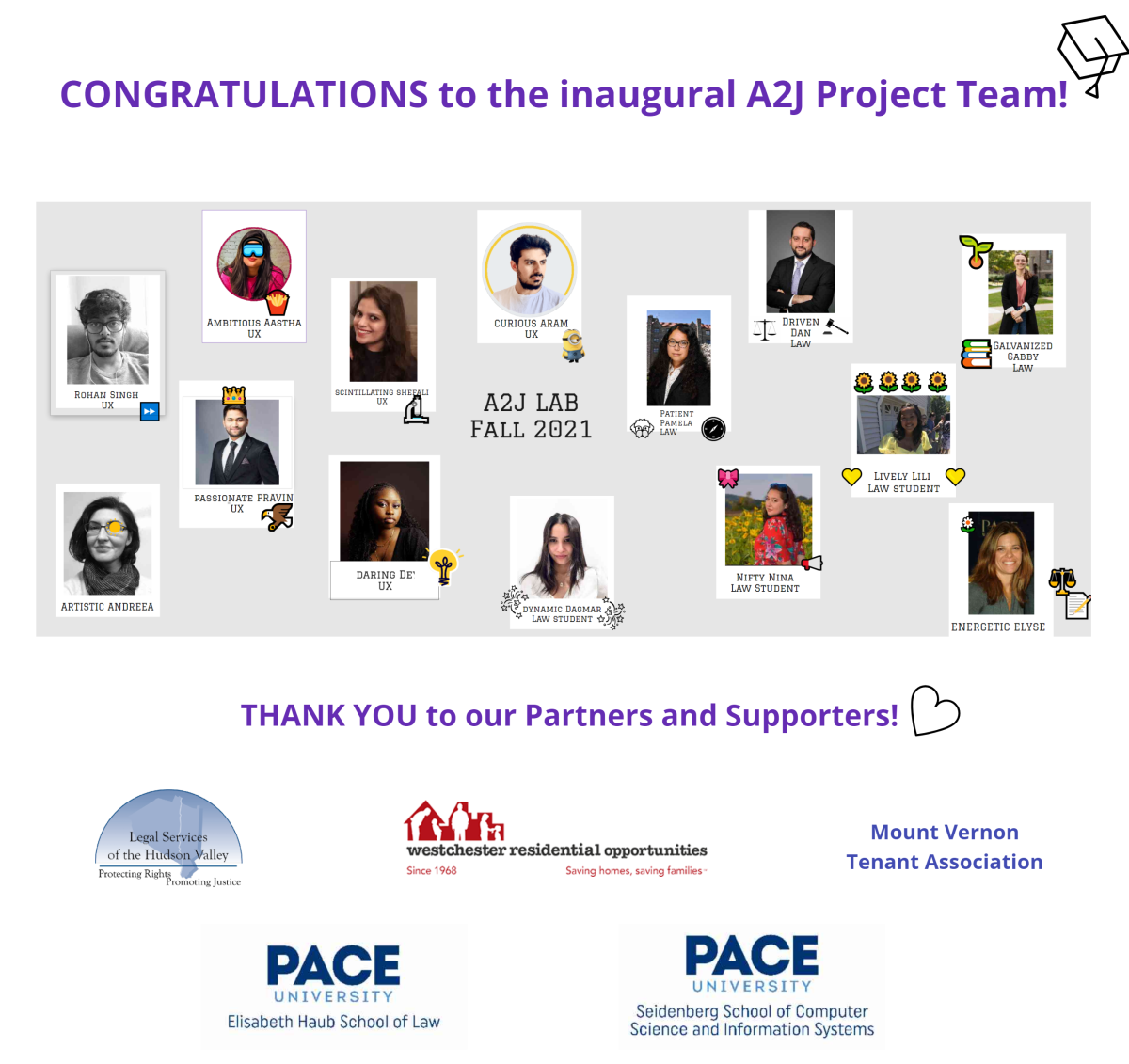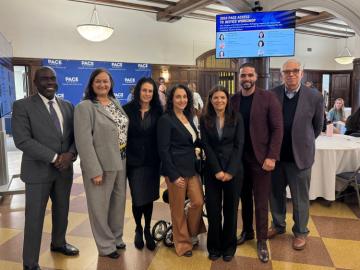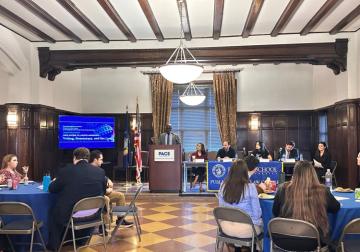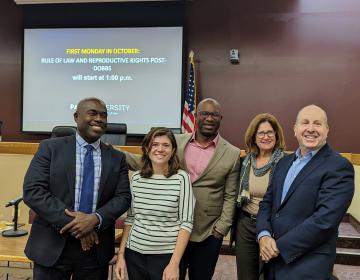Interdisciplinary Team of Students Collaborate to Develop Real-World Solutions in Haub Law’s First Access to Justice Lab
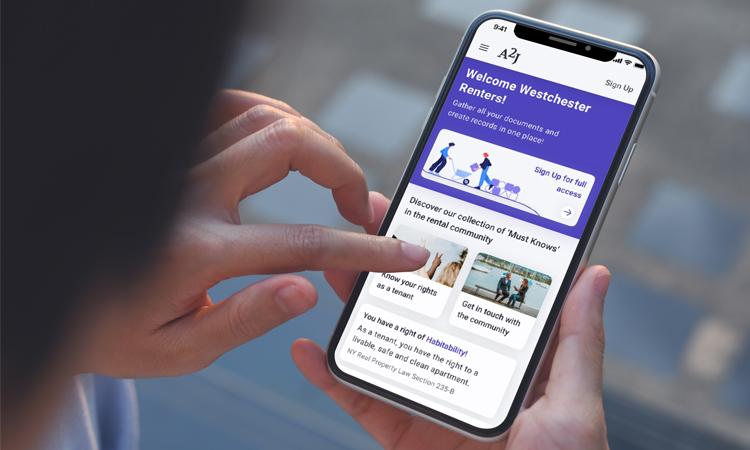
The Elisabeth Haub School of Law at Pace University’s new Access to Justice (A2J) Lab brought together students from across Pace University to apply human-centered design-thinking and legal training to create an innovative technology tool to address a real-world gap in access to justice. Six second and third year Haub Law students, Lili Caparosa, Dagmar Cornejo, Pamela Guerrero, Daniel Guarracino, Gabriella Mickel, and Nina Rodriguez, joined five graduate students and one undergraduate student from Seidenberg School of Computer Science and Information Systems to collaborate in the unique, immersive, and interdisciplinary course offered for the first time this semester.
The A2J Lab course is a key component of Haub Law’s new Pace Access to Justice Project, which aims to direct the combined legal knowledge, skill and energy among Pace faculty, staff and students to close gaps in access to justice in our communities. Led by Professor Elyse Diamond, Director of the Public Interest Law Center, and Seidenberg Clinical Professor Andreea Cotoranu, Director of the NYC Design Factory, the course challenged students to help low-income Westchester tenants facing serious rental apartment habitability issues, and guided students through the research and development of a technology application prototype to empower tenants.
“We tasked students to learn about the complex legal and social systems that impact tenants in Westchester facing health, safety, environmental, and livability issues by engaging directly with community stakeholders, and to identify truly practical solutions,” said Professor Diamond. “Multiple factors including limited affordable rental housing, multi-step and de-centralized complaint processes that vary by local municipality, and eviction fear, lead many Westchester tenants to feel helpless to address even serious health and safety issues in their apartments. Through user personas, stakeholder interviews, outside research, and synthesizing exercises, our team explored where in the process a technology tool could benefit tenants and their advocates and encourage helpful legal and policy solutions.”
During the design process discovery phase, the law students and undergraduate student researched applicable legal information, statistics, and stories, to help them understand this real-world A2J issue. “We learned that the housing stock in Westchester is old and unaffordable, forcing low-income tenants who do not have enough housing options or income to be selective, to take or remain in housing even if it is unsafe,” said Gabriella Mickel, a 2L student participant.
According to the Westchester County Housing Needs Assessment, “Over 70% of the housing stock is nearly 50 years old, which strongly suggests a high number of homes are in need of major rehabilitation” and over 11,000 affordable housing units are needed.
Students also interviewed community and legal housing advocates, including Mount Vernon United Tenants Executive Director, Dennis Hanratty; Westchester Residential Opportunities, Inc. Executive Director, Marlene Zarfes and Deputy Director, Andrew Smith; and Legal Services of the Hudson Valley’s Pro Bono Director, Christopher Oldi, Esq., Litigation Director, Marcie Kobak, and Intake Director, Shira Galinsky, Esq. These stakeholders helped students to understand the relevant legal processes, but also highlighted how impactful A2J technology could be. “One of the goals is just empowering people; most people don't believe they have much power,” said Dennis Hanratty.
After synthesizing information from the research phase, the law students, now joined by the graduate team from Seidenberg, spent several weeks developing a prototype for a website application meant to help address the power imbalance between tenants and landlords in Westchester. The tool, available in English and Spanish, was designed to allow mobile users to learn their rights and to record and track habitability issues in one easy-to-navigate place. It includes a resources section, a record-keeping feature with document generation and a checklist, data analytics to collect anonymous information that can be used for advocacy efforts, and a forum with private messaging. The Lab culminated in a team presentation and prototype demonstration to select stakeholders and faculty. Students came away from the experience with a deeper understanding about the barriers facing lower income tenants and how to help them navigate local legal and related processes. The inaugural A2J Lab class hopes to secure funding for the web app through private funders or competitions, to make this solution available to the public.
“The A2J Lab was a very informative, hands-on experience that challenged me to thoroughly understand the individual that I want to help, rather than rely on my prior assumptions,” said Pamela Guerrero, a 2L participant.
Haub Law Dean Horace Anderson attended the final presentation along with Seidenberg Dean Jonathan Hill who were both impressed by the outcome of the course.
“It’s amazing to see our vision for our A2J programs coming to fruition,” said Dean Anderson. “The new A2J Lab along with the complementary A2J Seminar are uniquely providing our students with the critical skills needed by lawyers today to identify, diagnose, and address access issues using tools and knowledge from multiple disciplines. These academic experiences, combined with practical training through our partnerships with Westchester County courts, the New York State Judicial Institute and other community partners will lay the groundwork for students to make an impact in racial and social justice reform.”
